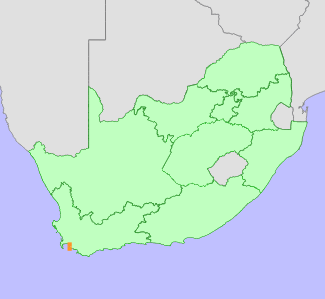|
Scientific Name | Leucospermum cordatum E.Phillips |
Higher Classification | Dicotyledons |
Family | PROTEACEAE |
Common Names | Heart-leaf Pincushion (e) |
National Status |
Status and Criteria | Endangered B1ab(iii,v)+2ab(iii,v) |
Assessment Date | 2020/05/24 |
Assessor(s) | A.G. Rebelo, D. Raimondo & L. von Staden |
Justification | Leucospermum cordatum is a restricted species endemic to the Western Cape Province of South Africa where it is confined to an area of 5 km². This species has an extent of occurrence (EOO) and area of occupancy (AOO) of 20 km². It is known from two locations and is experiencing ongoing decline in its habitat quality as a result of too frequent fires. It therefore qualifies for listing as Endangered under criterion B. |
Distribution |
Endemism | South African endemic |
Provincial distribution | Western Cape |
Range | This species is known from the lower slopes of the Kogelberg Mountain, in the Western Cape, South Africa. |
Habitat and Ecology |
Major system | Terrestrial |
Major habitats | Kogelberg Sandstone Fynbos, Cape Winelands Shale Fynbos |
Description | It occurs in sandstone fynbos associated with manganese deposits on screes. Mature individuals are killed by fires, and only seeds survive. Seeds are released after ripening, and dispersed by ants to their underground nests, where they are protected from predation and fire. It is pollinated by rodents. It has a generation length linked to natural fire cycles of between 15 and 20 years. |
Threats |
| This species was threatened in the past by the building of the road that runs directly through its limited habitat. Furthermore one of the subpopulations lost habitat in the past to Manganese mining. Currently both subpopulations are protected and fall within the Steenbras/Kogelberg Nature Reserve complex. However too frequent fires are a threat with over 30% of the population having been burnt in shorter than 10 year intervals over the past 20 years, with one section burning twice in the past 6 years (CapeNature 2019 fire records). Ignition events linked to passing motorists is a significant problem which is causing ongoing decline in habitat quality and the number of mature individuals. |
Population |
Leucospermum cordatum is known from two subpopulations separated from one another by 3 kms. The first at the former manganese mine site spans an area of 1.5 kms and consists of between 300 and 3000 plants, the second above Kogelbaai consists of between 100 and 1000 plants. The population is suspected to be declining as a result of too frequent fire. The rate and extent of decline is unknown.
|
Population trend | Decreasing |
Assessment History |
Taxon assessed |
Status and Criteria |
Citation/Red List version | | Leucospermum cordatum E.Phillips | EN B1ac(iv)+2ac(iv) | Raimondo et al. (2009) | | Leucospermum cordatum E.Phillips | Rare | Hilton-Taylor (1996) | | Leucospermum cordatum E.Phillips | Rare | Hall et al. (1980) | |
Bibliography |
Goldblatt, P. and Manning, J.C. 2000. Cape Plants: A conspectus of the Cape Flora of South Africa. Strelitzia 9. National Botanical Institute, Cape Town.
Hall, A.V., De Winter, M., De Winter, B. and Van Oosterhout, S.A.M. 1980. Threatened plants of southern Africa. South African National Scienctific Programmes Report 45. CSIR, Pretoria.
Hilton-Taylor, C. 1996. Red data list of southern African plants. Strelitzia 4. South African National Botanical Institute, Pretoria.
Manning, J.C. and Goldblatt, P. 2012. Plants of the Greater Cape Floristic Region 1: The Core Cape Flora. Strelitzia 29. South African National Biodiversity Institute, Pretoria.
Raimondo, D., von Staden, L., Foden, W., Victor, J.E., Helme, N.A., Turner, R.C., Kamundi, D.A. and Manyama, P.A. 2009. Red List of South African Plants. Strelitzia 25. South African National Biodiversity Institute, Pretoria.
Rebelo, T. 2001. Sasol Proteas: A field guide to the proteas of southern Africa. (2nd ed.). Fernwood Press, Vlaeberg, Cape Town.
|
Citation |
| Rebelo, A.G., Raimondo, D. & von Staden, L. 2020. Leucospermum cordatum E.Phillips. National Assessment: Red List of South African Plants version 2024.1. Accessed on 2025/12/23 |
 Comment on this assessment
Comment on this assessment

